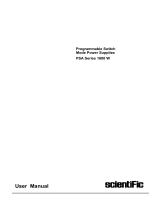
5
TABLE OF CONTENTS
Introduction ............................................................................................................................................................................ 7
Scope .................................................................................................................................................................................... 7
Calibration and Verification ............................................................................................................................................. 7
Troubleshooting................................................................................................................................................................ 7
Principles of Operation ..................................................................................................................................................... 7
Replaceable Parts.............................................................................................................................................................. 7
Circuit Diagrams............................................................................................................................................................... 7
Safety Considerations ........................................................................................................................................................... 7
Manual Revisions ................................................................................................................................................................. 8
Calibration and Verification.................................................................................................................................................. 9
Introduction........................................................................................................................................................................... 9
Test Equipment Required ..................................................................................................................................................... 9
Operation Verification Tests................................................................................................................................................. 9
Calibration Procedure ........................................................................................................................................................... 9
Initial Setup..................................................................................................................................................................... 12
Performance Tests .............................................................................................................................................................. 16
Measurement Techniques ............................................................................................................................................... 16
Constant Voltage (CV) Tests.......................................................................................................................................... 18
Constant Current (CC) Tests........................................................................................................................................... 24
Troubleshooting .................................................................................................................................................................... 27
Introduction......................................................................................................................................................................... 27
Initial Troubleshooting Procedures..................................................................................................................................... 27
Electrostatic Protection....................................................................................................................................................... 29
Repair and Replacement ..................................................................................................................................................... 29
A2 Control Board Removal ............................................................................................................................................ 30
A4 FET Board Removal ................................................................................................................................................. 30
A5 Diode Board Removal............................................................................................................................................... 31
A3 Front Panel Board Removal...................................................................................................................................... 31
A1 Main Board Removal................................................................................................................................................ 31
Overall Troubleshooting Procedure.................................................................................................................................... 32
Using the Tables ............................................................................................................................................................. 33
Main Troubleshooting Setup .......................................................................................................................................... 33
Troubleshooting No-Output Failures .............................................................................................................................. 36
Front Panel Troubleshooting........................................................................................................................................... 36
Troubleshooting Bias Supplies ....................................................................................................................................... 38
Power Section Blocks ..................................................................................................................................................... 40
Troubleshooting AC-Turn-on Circuits............................................................................................................................ 40
Troubleshooting PWM & Clock..................................................................................................................................... 41
Troubleshooting DC-To-DC Converter .......................................................................................................................... 42
Troubleshooting Down Programmer .............................................................................................................................. 42
Troubleshooting CV Circuit ........................................................................................................................................... 44
Troubleshooting CC Circuit............................................................................................................................................ 44
Troubleshooting OVP Circuit......................................................................................................................................... 45
Principles of Operation ........................................................................................................................................................ 47
Autoranging Power............................................................................................................................................................. 47
Overview............................................................................................................................................................................. 47
System Description............................................................................................................................................................. 47
Regulation & Control Subsystem ....................................................................................................................................... 48
Protection Subsystem.......................................................................................................................................................... 53
Input Power Subsystem ...................................................................................................................................................... 53






















